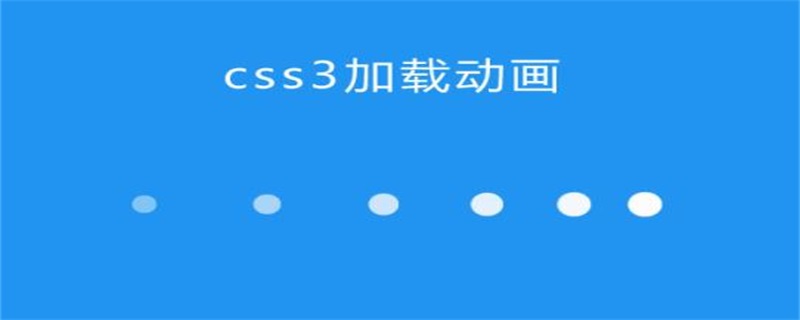How to achieve page loading effect with CSS3
CSS3 method to achieve page loading effect: first create an HTML sample file; then create a div in the body; finally achieve the page loading effect through animation animation and 2D scaling conversion in transform.

The operating environment of this article: Windows7 system, HTML5&&CSS3 version, Dell G3 computer.
We can make the animation of page loading into different shapes. The case we want to share today is to make the animation into a circular shape to load the page. When using animation, we should pay attention to browser compatibility issues
Detailed explanation of knowledge points
(1) animation: Set animation properties
animation-name: Set the keyframe name that needs to be bound to the selector. This example is bound to load
animation-duration: the time it takes to complete the animation, in seconds or milliseconds.
animation-timing-function: animation speed curve.
animation-delay: The delay before the animation starts.
animation-iteration-count: The number of times the animation should be played.
animation-direction: Whether the animation should be played in reverse in turn.
Example: Set the animation name to load, the time required to complete the animation is 1.4s, start and end at low speed, and play in an infinite loop
animation: load 1.4s infinite ease-in-out;
(2) animation-fill-mode attribute
none: Do not change the default behavior.
forwards: When the animation is completed, keep the last attribute value (defined in the last keyframe).
backwards: During the period of time specified by animation-delay, the start property value (defined in the first keyframe) is applied before the animation is displayed.
both: Both forward and backward fill modes are applied.
(3) transform: scale(x,y) 2D scaling transformation.
Complete code
<!DOCTYPE html>
<html>
<head>
<meta charset="UTF-8">
<title>Document</title>
<style>
.load {
margin:300px auto;
width: 150px;
text-align: center;
}
.load div{
width: 30px;
height: 30px;
background-color:rgb(118,224,250);
border-radius: 100%;
display: inline-block;
-webkit-animation: load 1.4s infinite ease-in-out;
-webkit-animation-fill-mode: both;
}
.load .circle1 {
-webkit-animation-delay: -0.32s;
}
.load .circle2 {
-webkit-animation-delay: -0.16s;
}
@-webkit-keyframes load {
0%, 80%, 100% { -webkit-transform: scale(0.0) }
40% { -webkit-transform: scale(1.0) }
}
</style>
</head>
<body>
<div class="load">
<div class="circle1"></div>
<div class="circle2"></div>
<div class="circle3"></div>
</body>
</html>[Recommended course: CSS3 tutorial】
Rendering

Dynamic rendering

Summary: The above is That’s the entire content of this article. Through the content of this article, I hope you will have a certain understanding of CSS3 animation and be able to create your favorite page loading style.
The above is the detailed content of How to achieve page loading effect with CSS3. For more information, please follow other related articles on the PHP Chinese website!

Hot AI Tools

Undresser.AI Undress
AI-powered app for creating realistic nude photos

AI Clothes Remover
Online AI tool for removing clothes from photos.

Undress AI Tool
Undress images for free

Clothoff.io
AI clothes remover

Video Face Swap
Swap faces in any video effortlessly with our completely free AI face swap tool!

Hot Article

Hot Tools

Notepad++7.3.1
Easy-to-use and free code editor

SublimeText3 Chinese version
Chinese version, very easy to use

Zend Studio 13.0.1
Powerful PHP integrated development environment

Dreamweaver CS6
Visual web development tools

SublimeText3 Mac version
God-level code editing software (SublimeText3)

Hot Topics
 1664
1664
 14
14
 1423
1423
 52
52
 1318
1318
 25
25
 1268
1268
 29
29
 1248
1248
 24
24
 How to Create an Animated Countdown Timer With HTML, CSS and JavaScript
Apr 11, 2025 am 11:29 AM
How to Create an Animated Countdown Timer With HTML, CSS and JavaScript
Apr 11, 2025 am 11:29 AM
Have you ever needed a countdown timer on a project? For something like that, it might be natural to reach for a plugin, but it’s actually a lot more
 HTML Data Attributes Guide
Apr 11, 2025 am 11:50 AM
HTML Data Attributes Guide
Apr 11, 2025 am 11:50 AM
Everything you ever wanted to know about data attributes in HTML, CSS, and JavaScript.
 A Proof of Concept for Making Sass Faster
Apr 16, 2025 am 10:38 AM
A Proof of Concept for Making Sass Faster
Apr 16, 2025 am 10:38 AM
At the start of a new project, Sass compilation happens in the blink of an eye. This feels great, especially when it’s paired with Browsersync, which reloads
 While You Weren't Looking, CSS Gradients Got Better
Apr 11, 2025 am 09:16 AM
While You Weren't Looking, CSS Gradients Got Better
Apr 11, 2025 am 09:16 AM
One thing that caught my eye on the list of features for Lea Verou's conic-gradient() polyfill was the last item:
 How to Build Vue Components in a WordPress Theme
Apr 11, 2025 am 11:03 AM
How to Build Vue Components in a WordPress Theme
Apr 11, 2025 am 11:03 AM
The inline-template directive allows us to build rich Vue components as a progressive enhancement over existing WordPress markup.
 A Comparison of Static Form Providers
Apr 16, 2025 am 11:20 AM
A Comparison of Static Form Providers
Apr 16, 2025 am 11:20 AM
Let’s attempt to coin a term here: "Static Form Provider." You bring your HTML
 The Three Types of Code
Apr 11, 2025 pm 12:02 PM
The Three Types of Code
Apr 11, 2025 pm 12:02 PM
Every time I start a new project, I organize the code I’m looking at into three types, or categories if you like. And I think these types can be applied to
 PHP is A-OK for Templating
Apr 11, 2025 am 11:04 AM
PHP is A-OK for Templating
Apr 11, 2025 am 11:04 AM
PHP templating often gets a bad rap for facilitating subpar code — but that doesn't have to be the case. Let’s look at how PHP projects can enforce a basic




